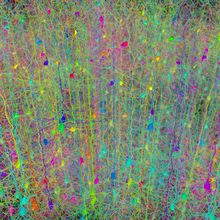In silico
In silico (based on the Latin in silicio for in silicon ) describes processes that take place in the computer. The term is a reference to the fact that most of today's computer - the chip on the basis of the chemical element silicon are produced (see also the wafer ).
General
The term originated in the field of bioinformatics , which offers computer support for the elucidation of biochemical processes in living organisms , in particular the cells of the human organs. The classic elucidation of processes in the cells takes place through an experiment - in vivo means the observation in a fully viable organism, while in vitro means the observation of sub-processes in a laboratory environment (e.g. test tube or Petri dish ). Computer-aided simulation of the associated biochemical processes can now be used to initiate experiments in the computer, and the calculated results can be handled like other experimental observations - one then speaks of an experiment in silico .
As a rule, experimental results must each be subjected to an increased test. For a conspicuous biochemical process in the computer (in silico) , a laboratory experiment must be used, which also shows the process, so that inaccuracies in the model do not lead to false assumptions for further research. The laboratory experiments carried out (in vitro) must also be checked, as a natural organism reacts to an initiated biochemical process and there is an interaction with other active biochemical processes, so that the actual effect on living beings ( in vivo ) can be different than that of the simplified environmental conditions of the laboratory was observed.
Concept history
The term in silico is not Latin. The word creation originated in the southwest of the USA and northwest of Mexico, where it was used several times at conferences on genome research in 1989/1990 to describe the computer experiments that take place parallel to the in vitro and in vivo experiments. Here you can see a reference to the silicon used in the computer chips, which is called silicon in the English language and in the southwest of the USA is also the namesake for Silicon Valley ("silicon valley "), the main location of the computer industry worldwide. There is a direct association there between silicon and computers, by aligning the end of the sound (rhyme formation) with in viv o and in vitr o , so presumably resulted in silicon o . The term established itself quickly, the first written testimony can be found in 1990 by Hans B. Sieburg in the transcripts of the summer colloquium on complex systems at the Santa Fe Institute and in 1991 in a checked article by a French team in an international journal. At the beginning of the 1990s, attempts were made to introduce a correct Latin equivalent in silicio , but this did not succeed. The technical term appears regularly in the white papers of the European Community on genome research.
See also
Individual evidence
-
↑ Information from Pedro Miramontes, whose doctoral thesis in mathematics appeared some time later,
Pedro Eduardo Miramontes Vidal: Un modelo de autómata celular para la evolución de los ácidos nucleicos. Tesis de Doctorado, Universidad Nacional Autónoma de México , México 1992 ( ru.dgb.unam.mx , Spanish). -
^ Hans B. Sieburg: Physiological studies in silico . In: Studies in the Sciences of Complexity . tape 12 , 1991, pp. 321-342 . See also: Hans B. Sieburg: Physiological studies in silico . In: Lynn Nadel, Daniel I. Stein (Ed.): 1990 Lectures In Complex Systems (= Santa Fe Institute Studies in the Sciences of Complexity . Lecture Volume 3). CRC Press, Boca Raton 2018, ISBN 978-0-429-97212-6 , pp.
367–390 ( limited preview in Google Book search). - ↑ A. Danchin, C. Médigue, O. Gascuel, H. Soldano, A. Hénaut: From data banks to data bases . In: Research in Microbiology . tape 142 , no. 7-8 , October 1991, pp. 913-916 , doi : 10.1016 / 0923-2508 (91) 90073-j , PMID 1784830 .
